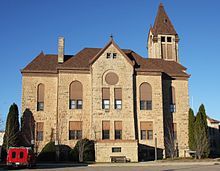In 1876, John Blinn built a mill in one of the beautiful valleys of southeastern Minnesota. An article in an 1887 mill paper brought the mill to the attention of Michael Schech, a master miller who had immigrated from Bavaria and was employed at one of the large mills in Minneapolis. Schech purchased the mill which was operated by Schech’s brother until 1890 when Michael Schech relocated their family to their Beaver Creek Valley home in Houston County. The mill became known as Schech’e Mill.
Michael and his sons, Fred and Edward, took over operation of the mill. Their products included “Schech’s Best Flour” cornmeal, rye buckwheat, graham flour and whole-wheat cereal, which were sold to stores in Houston and Caledonia. Power for the mill came from three Leffel turbines and one Sampson turbine. The equipment included four run of 22” Diamond buhrstones, a roller mill, crusher, sheller, bolters, and related elevators.
When Michael retired in 1913, Edward took over the operation. In 1922, a concrete dam replaced the old wooden one and two years later a concrete water wheel pit was constructed. After Edward’s death in 1941, his wife continued operating the mill for the next five years.
In 1946, Edward’s daughter, Eleanor, and her husband Ivan took over all mill operations. Eleanor and Ivan’s son Edward began helping with operations in 1960. “Every September their son Edward would come over and help clean the mud from the turbine pit”, said Ivan.
Since Eleanor and Ivan’s death Edward and his wife Joanie have run the mill. Schech’s Mill was nominated for the National Registry of Historic Places in 1977. At that time it was the only mill in the state to contain unchanged, operable milling equipment and to have its original stone. It is one of only three mills in the state to operate solely on water power

